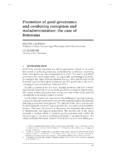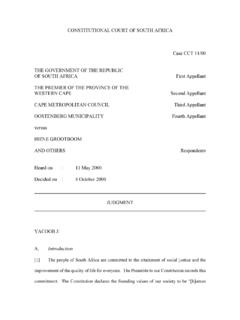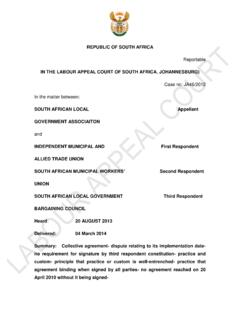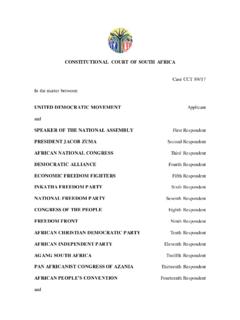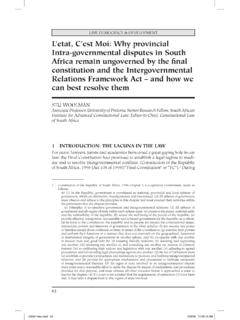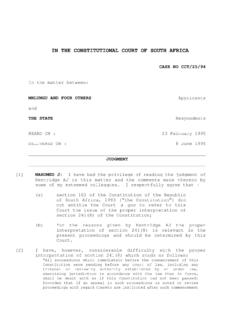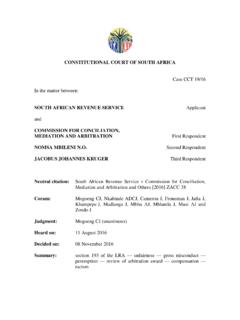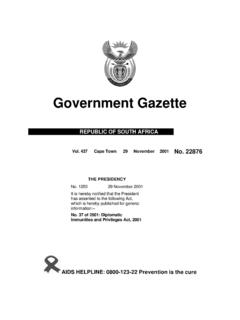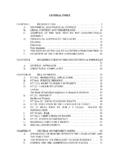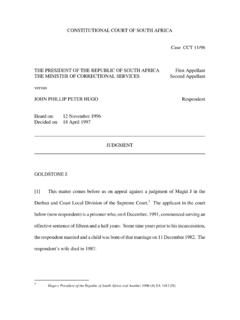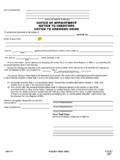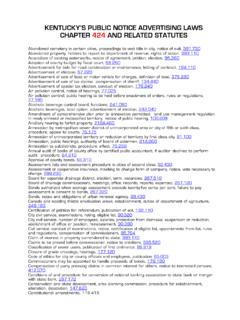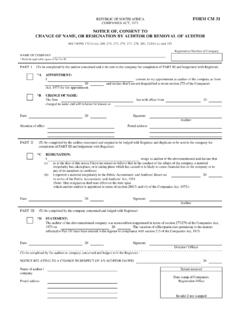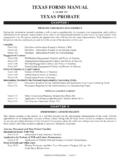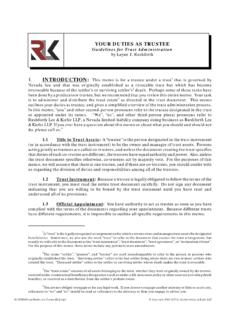Transcription of CONSTITUTIONAL COURT OF SOUTH AFRICA Case …
1 CONSTITUTIONAL COURT OF SOUTH AFRICA Case CCT 9/97 JEANETTE HARKSEN (BORN TZSCHUCKE) Applicant versus MICHAEL JOHN LANE NO First Respondent EILEEN MARGARET FEY NO Second Respondent THE MASTER OF THE SUPREME COURT Third Respondent THE MINISTER OF JUSTICE Fourth Respondent Heard on: 26 August 1997 Decided on: 7 October 1997 JUDGMENT GOLDSTONE J: Introduction [1] In this case the constitutionality of certain provisions of the Insolvency Act 24 of 1936, as amended ( the Act ), comes before us by way of a referral from Farlam J in the Cape of Good Hope Provincial High Court1 made in terms of section 102(1) of the Constitution of the Republic of SOUTH AFRICA Act 200 of 1993 ( the interim Constitution ).
2 1 Harksen v Lane & Others (C) Case No 16552/96, 25 March 1997, unreported. [2] The referral came about in consequence of the sequestration of the estate of Mr J rgen Harksen ( Mr Harksen ). The final sequestration order was granted in the Cape of Good Hope Provincial Division of the Supreme COURT (as it then was) on 16 October 1995. The applicant in these proceedings, Mrs Jeanette Harksen ( Mrs Harksen ), was at that time married out of community of property to Mr Harksen. The first and second respondents are the trustees in the insolvent estate of Mr Harksen ( the trustees ). The third respondent is the Master of the Cape of Good Hope Provincial High COURT ( the Master ). The fourth respondent is the Minister of Justice ( the Minister ).
3 [3] There was no appearance in this COURT on behalf of the trustees, the Master or the Minister. We were informed by the trustees that there were insufficient funds in the insolvent estate to allow them to brief counsel. They, as did the other respondents, informed the COURT that they will abide its decision on the questions referred to it. Mr W Trengove SC and Mr D Spitz appeared on behalf of an amicus curiae, the Council of SOUTH African Banks. We are indebted to the amicus, and especially to its counsel, for the most helpful heads of argument they filed and oral submissions they made at the hearing of the referral. [4] As indicated above, the sequestration of the insolvent estate of Mr Harksen commenced in October 1995, during the period of operation of the interim Constitution.
4 Section 4(1) of the interim Constitution provided that: This Constitution shall be the supreme law of the Republic and any law or act GOLDSTONE J 3 inconsistent with its provisions shall, unless otherwise provided expressly or by necessary implication in this Constitution, be of no force and effect to the extent of the inconsistency. Section 7(2) provided that: This Chapter shall apply to all law in force .. during the period of operation of this Constitution. In accordance with these sections any provision of a law inconsistent with the bill of rights became invalid and of no force and effect upon the coming into operation of the interim [5] The Constitution of the Republic of SOUTH AFRICA , 1996 ( the 1996 Constitution ) came into force on 4 February 1997.
5 Although the matter was referred to this COURT on 25 March 1997, the application for the referral was launched on 18 December 1996, prior to the coming into operation of the l996 Constitution. It was therefore pending on the date on which the 1996 Constitution came into operation. Item 17 of schedule 6 to the 1996 Constitution provides that: 2 Ferreira v Levin NO and Others; Vryenhoek and Others v Powell NO and Others 1996 (1) SA 984 (CC); 1996 (1) BCLR 1 (CC) at para 28. GOLDSTONE J 4 All proceedings which were pending before a COURT when the new Constitution took effect, must be disposed of as if the new Constitution had not been enacted, unless the interests of justice require otherwise. [6] In the present case it was accepted by counsel that there were no interests of justice which required the referral to be decided in accordance with the 1996 Constitution.
6 I can find no ground for holding that such interests obtain in this case. It follows that the provisions and procedures of the interim Constitution apply to the matter referred and the constitutionality of the impugned sections must be decided with reference thereto. The Relevant Provisions of the Act [7] In this case the sections of the Act which are impugned are sections 21, 64 and 65. They are alleged to be inconsistent with certain provisions of the bill of rights to the extent that they impact on the property and affairs of a solvent spouse upon the sequestration of the estate of an insolvent spouse. At the outset, it is convenient to set out the relevant provisions of the Act. [8] In terms of section 20(1) of the Act, the effect of the sequestration of the estate of an insolvent is to divest the insolvent of his or her estate and to vest it in the Master until a trustee has been appointed.
7 Thereafter the estate vests in the trustee. Section 21(1) of the Act provides: GOLDSTONE J 5 The additional effect of the sequestration of the separate estate of one of two spouses who are not living apart under a judicial order of separation shall be to vest in the Master, until a trustee has been appointed, and, upon the appointment of a trustee, to vest in him all the property (including property or the proceeds thereof which are in the hands of a sheriff or a messenger under a writ of attachment) of the spouse whose estate has not been sequestrated (hereinafter referred to as the solvent spouse) as if it were property of the sequestrated estate, and to empower the Master or trustee to deal with such property accordingly, but subject to the following provisions of this section.
8 There then follow a number of provisions3 which are designed to protect the legitimate interests of the solvent spouse. [9] In terms of the section4 spouse refers not only to a wife or husband in the legal sense but also to a wife or husband married according to any law or custom, as well as women and men living with each other as if they were married. [10] Section 21(2) provides that once the solvent spouse proves that his or her property falls into one of the following categories, the trustee shall release it: (a) property of the solvent spouse acquired before her or his marriage to the insolvent or before 1 October, 1926; 3 See ss 21(2), (3), (4) and (10). 4 Section 21(13). GOLDSTONE J 6 (b) property acquired by the solvent spouse under a marriage settlement; (c) property acquired by the solvent spouse during the marriage by a title valid as against creditors of the insolvent; (d) those policies of life insurance which are protected by the provisions of the Insurance Act 27 of 1943; (e) property acquired with, or with the income or proceeds of, property referred to above.
9 [11] The category of property acquired by the solvent spouse during the marriage by a title valid against creditors of the insolvent was substantially widened by section 22 of the Matrimonial Property Act 88 of 1984. In terms thereof, donations between spouses, formerly invalid, were made legal and therefore enforceable. Some of the effects of that development on section 21 of the Act were considered by Kriegler J in Snyman v Rheeder At the outset, the learned Judge referred to a passage from the judgment of Greenberg JP in Maudsley s Trustee v Part of that passage reads as follows: 5 1989 (4) SA 496 (T) at 504H-506B. 6 1940 TPD 399 at 404. GOLDSTONE J 7 Apart from authority I see no reason why the words title valid as against creditors should have any special meaning, and why they should not mean a title which under the provisions of the law are so valid.
10 In other words, there is nothing in sec. 21(c) which creates any new ground of validity or invalidity and all that is effected by sec. 21 in relation to property which is claimed by the solvent spouse to fall under sec. 21(c) is that the onus is cast on the spouse to prove the validity whereas under the law before 1926 the onus rested on the trustee to prove the invalidity. One knows that before the amendment of the law in 1926, it was a common practice for traders (and perhaps others) to seek to avoid payment of their debts by putting property in their wives names; on insolvency the burden rested on the trustee to attack the wife s title. If sec. 21 is regarded as merely shifting the onus on to the solvent spouse, it nevertheless affords some relief in the direction of preventing the evil to which I have referred.
